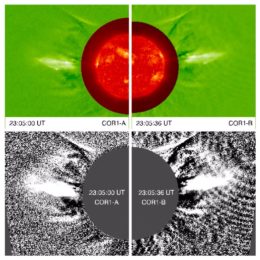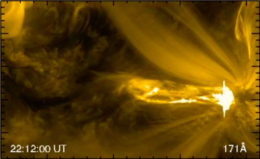Our Sun often exhibits a roiling surface full of activity. But how do the different types of eruptions and disturbances we see relate to one another? Observations of one explosive jet are helping us to piece together the puzzle.
Looking for Connections
Energy travels through and from the Sun via dozens of different phenomena. We see ultraviolet waves that propagate across the disk, loops and flares of plasma stretching into space, enormous coronal mass ejections that expel material through the solar system, and jets of all different sizes extending from the Sun’s surface and atmospheric layers. A longstanding mission for solar physicists has been to relate these phenomena into a broader picture explaining how energy is released from our closest star.
Positions of the two STEREO satellites relative to the Sun and the Earth. SDO orbits the Earth. The green arrow shows the eruption direction of the blowout jet. [Miao et al. 2018]
An Enlightening Explosion
On 9 March 2011, a coronal blowout jet erupted from the Sun’s surface. Three spacecraft were on hand to watch: the Solar Dynamics Observatory, STEREO Ahead, and STEREO Behind. These observatories were each located roughly 90° from each other, providing a view of the Sun’s surface from multiple angles at the moment of the explosion.
What did they these observatories see?
- The flare
The eruption of the blowout jet — which lasted ~21 minutes — was accompanied by a class 9.4 solar flare. - The wave
Shortly after the jet launch, an arc-shaped extreme ultraviolet (EUV) wave appeared on the southeastern side of the jet. This wave lasted ~4 minutes and propagated away from the site of the jet. - The jet
The jet itself contains both bright and dark material. The dark material appears to be due to a mini-filament — a thread of cool, dense gas suspended above the Sun’s surface by magnetic fields — that erupted in the jet base. - The coronal mass ejection
The two STEREO spacecraft captured what happened on large scales in the outer corona of the Sun, revealing an explosive coronal mass ejection spewing matter into space. The ejection consisted of two structures: a jet-like component and a bubble-like component.
Causal Ties?

STEREO Ahead (left) and Behind (right) images of the coronal mass ejection in the outer corona. Both a jet-like and a bubble-like component can be seen. [Miao et al. 2018]
In particular, the authors propose a relation in which the EUV wave was a fast-mode magnetohydrodynamic wave driven by the blowout jet eruption. They also suggest that the jet-like component of the coronal mass ejection is the outer-corona extension of the hot part of the blowout jet body, while the bubble-like component might be associated with the eruption of the mini-filament at the jet base.
More observations like those of this event are needed to draw definitive conclusions, but this explosion has provided some definite clues about the relationship between different phenomena as the Sun lashes out into its surroundings.
Bonus
Watch the propagation of the EUV wave (top video), the eruption of the blowout jet (middle video), and the coronal mass ejections (bottom video) in the clips below.
Citation
“A Blowout Jet Associated with One Obvious Extreme-ultraviolet Wave and One Complicated Coronal Mass Ejection Event,” Y. Miao et al 2018 ApJ 869 39. doi:10.3847/1538-4357/aaeac1

